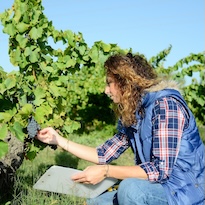[This article originally appeared in December 2009 on my former blog, FunhogSpins, which eventually evolved into the Indoor Cycling Association. It draws a unique comparison between indoor cycling instructors and winemakers, highlighting how their skills and education behind the scenes create an amazing product.]
Much like a fine wine, a well-crafted indoor cycling class is the result of expertise, experimentation, and careful refinement. The consumer—in this case, the student in cycling class—may or may not understand the science behind it—they only know this is their favorite instructor, the one who consistently delivers an incredible experience.
This connection between craftsmanship and expertise first struck me when I read The Widow Clicquot, a fascinating book about Barbe-Nicole Clicquot, the widow who turned Veuve Clicquot into the powerhouse champagne brand it is today. The book dives into her journey as a rare female entrepreneur in the early 1800s, but it also offers an insightful look at winemaking; that’s what sparked this analogy.
The Science Behind the Art
The best winemakers are part artist, part scientist. They master the chemistry of fermentation and the artistry of blending varietals to create a bottle that delights the senses. Mother Nature plays a role, of course—the perfect balance of sun, soil, rain, and temperature makes for an exceptional vintage. But even in a perfect year, it’s the winemaker’s skill that elevates the wine from good to unforgettable. When conditions are less than ideal (as they usually are), that expertise becomes even more vital. A little more of this grape, a little less of that one; maybe a longer aging process—every decision shapes the final product.
The people enjoying the wine rarely think about all that. They just know they love how it tastes and how it makes them feel.
The Instructor as the Winemaker
As an indoor cycling instructor, you’re the winemaker of your class. You study the science of exercise physiology, energy systems, biomechanics, and cycling technique, then blend that knowledge with music, motivation, and mindfulness to create an experience that feels effortless and energizing for your riders. Each ride is a carefully balanced mix of resistance, cadence, and power output—like a winemaker selecting the perfect varietals and aging methods to craft an unforgettable bottle. Some classes are high-intensity, some are intense but sustainable threshold efforts, and others focus on steady-state endurance or mental resilience, but all are shaped with intention.
Your students may not understand why it works—they just know your class feels different. Better. They know they feel stronger, fitter, and more accomplished when they walk out of your class. There’s something about your teaching that sets you apart—a certain je ne sais quoi that keeps them hooked.
Just like winemakers can’t produce a perfect vintage every year, you won’t create a masterpiece every single class. But that’s where your knowledge shines. Even on an “off” day when the energy is low, the playlist doesn’t hit quite right, or you find yourself distracted by life, your skills ensure your riders still get a great experience.
A Sip of Knowledge, or Just Savor the Ride?
Sometimes, it’s fun to share a bit of the science with your students—just enough to pique their curiosity, like a wine tasting that explains why a particular vintage tastes the way it does. Maybe you drop a nugget about how endurance rides train slow-twitch muscle fibers, or why working just below threshold improves oxygen delivery, which translates to better stamina. A little insight helps students appreciate their workouts more and strengthens their connection to you as an instructor.
Other times, you let the class speak for itself, no explanations needed. It’s like enjoying a glass of wine on the patio with friends, savoring the moment without overthinking it.
Whether you’re blending beats and drills or fermenting grapes and sugars, the goal is the same: to create something memorable and meaningful. Some classes will be vintage-worthy; others will simply be a satisfying, solid ride—and that’s okay.
Raise a glass to your students, your skills, and the magic you create. Chin chin!
A Bit of Backstory:
As a cycling tour guide in France and Italy since 1989, I’ve had the privilege of riding through legendary wine regions and experiencing tastings at local vineyards. One of my favorite memories is from Alsace, a region in northeastern France near the German border. My friends Martial and Catherine Dirringer, whom I met during a self-supported cycling trip in 1988, own a vineyard there. They produce primarily Rieslings and Gewürztraminers — not usually my go-to wines, but when paired with Alsatian cuisine, they’re divine.
One year, I was lucky enough to help with the harvest. I picked grapes, watched the pressing and fermentation processes, and marveled at the precision involved. Martial showed me how he analyzed the grapes’ residual sugars to determine the perfect moment for harvesting. “Not yet—this vineyard needs another day or two,” he’d say, and then point out a different plot ready for harvesting and say, “We’ll pick those first.”
The best part of being there at this time of the year? The nightly harvest feasts, complete with bottles from previous vintages. It’s an experience I’ll never forget—the kind of thing that stays with you forever.
Just like an unforgettable cycling class. 🍷🚴♀️



1 Comment